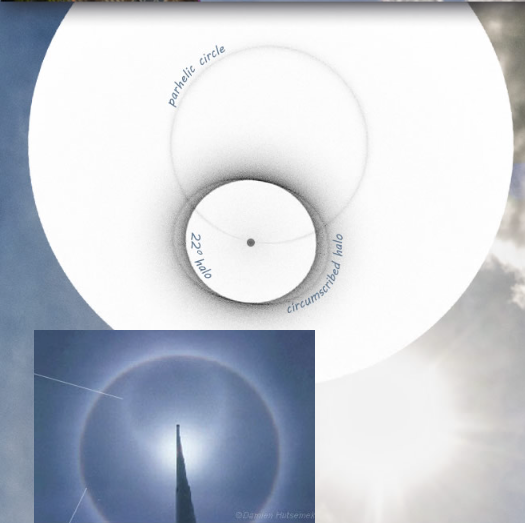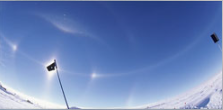High Sun Halos - OPOD
High Sun Halos - A Spectacular Phenomenon
When it comes to atmospheric optics, one of the most fascinating and visually striking phenomena is the occurrence of high sun halos. While most people are familiar with the common 22° halo that forms around the sun, high sun halos offer a unique and captivating spectacle during the spring and summer months. These halos appear higher in the sky and are often similar in size to the 22° halo.
A Rare Sight
Captured by Adam Kraft over Michigan, an image showcases the beauty of high sun halos. With the sun positioned directly overhead, the parhelic circle, which is typically quite large, can shrink to zero size. The photograph also reveals the presence of a circumscribed halo, caused by horizontal column crystals. These column crystals, along with plate crystals, contribute to the formation of the parhelic circle.
The Role of Crystals
High sun halos are formed due to the interaction of sunlight with ice crystals present in the atmosphere. These ice crystals can take on various shapes, including plates and columns. The orientation and position of these crystals play a crucial role in the appearance of different types of halos. When the sun is at a high angle in the sky, such as during spring and summer, the crystals align in a way that produces these unique halos.
Parhelic Circles and Their Shifting Size
The parhelic circle is a circular halo that runs parallel to the horizon and intersects with the 22° halo. Typically, it is much larger than the 22° halo and extends outwards from it. However, during high sun conditions, the parhelic circle can shrink in size. In extreme cases, it may even disappear entirely. This reduction in size is attributed to the sun's position directly overhead, causing the halo to appear smaller and closer to the observer.
Understanding Circumscribed Halos
The circumscribed halo, as seen in Adam Kraft's image, is another fascinating feature associated with high sun halos. It appears as a bright spot of light located at the intersection of the parhelic circle and the 22° halo. This halo is formed by the presence of horizontally-oriented column crystals in the atmosphere. These crystals interact with sunlight, resulting in the formation of the circumscribed halo.
Exploring Atmospheric Optics
Atmospheric optics is a branch of science that delves into the study of how light interacts with the Earth's atmosphere. It encompasses a wide range of phenomena, including halos, rainbows, and mirages. High sun halos provide a unique opportunity to witness the intricate interplay between sunlight and ice crystals in the atmosphere. By understanding the underlying principles behind these phenomena, scientists can gain valuable insights into atmospheric conditions and processes.
The Beauty of Natural Phenomena
Nature never ceases to amaze us with its breathtaking displays, and high sun halos are no exception. The ethereal and otherworldly appearance of these halos serves as a reminder of the complexity and beauty of our natural world. Whether observed in person or through captivating photographs, high sun halos leave a lasting impression on those fortunate enough to witness them.
A Reminder of Earth's Wonders
High sun halos are a reminder that there is still much to learn about our planet and its atmospheric dynamics. While scientists have made significant progress in understanding atmospheric optics, there is always more to discover. The study of high sun halos provides valuable insights into the behavior of light in the atmosphere and contributes to our overall understanding of the Earth's complex systems.
An Invitation to Observe
For those interested in experiencing high sun halos firsthand, spring and summer offer the best opportunities to do so. During these seasons, the higher position of the sun in the sky increases the likelihood of witnessing these remarkable optical phenomena. Keep an eye on the sky, particularly during clear days, and be prepared to be captivated by the awe-inspiring beauty of high sun halos.
Conclusion
High sun halos are a captivating sight that adds to the wonder and intrigue of atmospheric optics. With their unique appearance and shifting sizes, these halos offer a glimpse into the complex interplay between sunlight and ice crystals in the atmosphere. By exploring and understanding these phenomena, we gain a deeper appreciation for the natural wonders that surround us. So, next time you find yourself enjoying a sunny day, take a moment to look up and marvel at the mesmerizing display of high sun halos in the sky.

High Sun Halos
The higher sun of spring and summer is an opportunity to see a less usual parhelic circle. Here it is high in the sky and not much larger than the 22° halo.
Imaged by Adam Kraft over Michigan.
©Adam Kraft, shown with permission

In extremis, with the sun overhead, the usually huge parhelic circle can shrink to zero size.
Adam Kraft's image also shows a circumscribed halo from horizontal column crystals.
Columns help form the parhelic circle as do plate crystals.

Note: this article has been automatically converted from the old site and may not appear as intended. You can find the original article here.
Reference Atmospheric Optics
If you use any of the definitions, information, or data presented on Atmospheric Optics, please copy the link or reference below to properly credit us as the reference source. Thank you!
-
<a href="https://atoptics.co.uk/blog/high-sun-halos-opod/">High Sun Halos - OPOD</a>
-
"High Sun Halos - OPOD". Atmospheric Optics. Accessed on November 26, 2024. https://atoptics.co.uk/blog/high-sun-halos-opod/.
-
"High Sun Halos - OPOD". Atmospheric Optics, https://atoptics.co.uk/blog/high-sun-halos-opod/. Accessed 26 November, 2024
-
High Sun Halos - OPOD. Atmospheric Optics. Retrieved from https://atoptics.co.uk/blog/high-sun-halos-opod/.